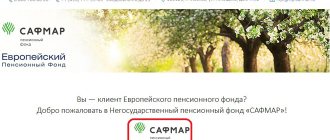NPF "Volga-Capital" is a non-profit organization working in the field of social security since 1999.
Initially, the fund was called “Signalman”. During the first year of its activity, pension agreements were concluded by 80 organizations in the communications industry. A year later, the NPF served about ten thousand people.
Activities of NPF, official website
In 2003, AK BARS Bank and Insurance were included among the founders. At the same time, the name was changed to NPF Volga-Capital. The Ministry of Finance of the Republic of Tatarstan authorized this organization to implement a program aimed at non-state provision of pensions for public sector employees.
The official website of NPF Volga-Capital contains detailed information about:
- Programs implemented by the fund;
- Terms of service for depositors;
- Reliability and profitability;
- Financial indicators;
- Services for corporate clients.
Here you also have access to your personal account, where you can find out the size of your savings. There is a service for obtaining expert advice; you can calculate pension payments using a special calculator.
General information about NPF Volga-Capital
Volga Capital was originally created and functioned as a regional non-state pension fund. Today, its main market is still Tatarstan, but it is also replenished with other depositors and insured persons. In terms of profitability, it is in fifth place based on performance results for the first 9 months of 2021. Savings are guaranteed by the deposit insurance agency.
Reference! The main ultimate shareholder of the fund, owning more than 50% of the share, is the Government of the Republic of Tatarstan (directly and through other established companies, as well as Ak Bars Bank, 20% of which is owned by a constituent entity of the Russian Federation).
Reliability rating
NPF Volga-Capital does not participate in the assessment of the National Rating Agency. At the end of 2021, Expert RA confirmed a very high level of reliability “A+”. In addition, the outlook changed to positive instead of stable. Accordingly, the likelihood of the rating improving in the future is very high.
This rating has been assigned to the fund for the past four years. The organization has repeatedly won awards in the fields of finance, social insurance, and pensions.
Defaults 2019: new names
There were a relatively small number of defaults last year: 32 companies across 61 issues failed to pay their bond obligations. However, most of them have already defaulted in previous years. 10 companies representing 23 securities became “newcomers” on the default lists. Let us list the main reasons for each of them.
Summary table of issuers and issues that defaulted on obligations for the first time in 2021
Source: Cbonds
Volga Capital – distressed investment assets
Volga Capital is a small investment company that operates in the financial market, operates as a liquidity operator, specializes in exchange transactions and direct investments in its own projects. In 2017-2018, Volga Capital carried out several direct investment transactions that led to problems already in the company itself.
In August 2021, it acquired a 79.99% stake in the Novosibirsk Refinery for RUB 704 million. In February 2021, Volga Capital purchased the remaining stake in the enterprise for 410 million rubles, and also acquired a stake in the authorized capital of Investment LLC in the amount of 43.56% for 151 million rubles.
As a result, investments in both assets turned out to be unsuccessful. On July 11, 2019, the Central Bank canceled the license of the investment company Vitus due to repeated violations of the law, and already in November 2021, a sign of large-scale problems was the sale of the refinery, which did not live up to its investment expectations.
Digital-Invest and Region-Invest - financial fraud within the Moscow Ring
In the well-known illegal scheme, within one link of which B&N Bank participated, other investment companies also functioned. These included Digital-Invest and Region-Invest - issuers collectively formed 14 default bond issues in 2021. Its detailed diagram was previously explained in “Brain” on Smartlab:
“In short, the essence of the scheme was as follows: the bonds of Digital Invest LLC were placed first, the main buyer was initially Rost Bank, which immediately resold the bonds to Region Invest LLC. Region Invest LLC pledged them to B&N Bank via repo, receiving money to purchase new bonds of Digital Invest LLC. As a result, the money received by Digital Invest LLC and Region Invest LLC from issuing bonds was mostly used to purchase foreign currency bonds of the Cypriot companies Belyrian and Bradinor, which in turn bought foreign currency bills of Russneft.”
All issues were non-market: none of the private and institutional investors were harmed (except for the beneficiaries of banks that are still being rehabilitated to this day).
Solomensky timber mill - unsuccessful investments in core assets
The company was the largest enterprise in the Republic of Karelia for felling, selling timber and wood processing.
Since 2014, the company began active investment activities: acquired imported forestry equipment, became the owner of other forest industry enterprises (CJSC Shuyales, PJSC Petrarco and LLC Porosozero).
However, almost immediately these companies began to generate regular losses for Solomensky Leskhoz: most of the company’s balance sheet represented investments in these companies, which partially covered the financial debt, but brought disproportionately low returns. As a result, the company suffered losses, and starting in 2018, the process of transferring assets abroad began.
On August 19, 2021, Solomensky Leso, as a representative of the bankrupt banks holding the bonds, filed a claim to recover the par value of the bonds, coupon income and interest for a total amount of more than 3.3 billion rubles.
TTB Invest Production and Metalenergomontazh – technical defaults on the same day
Metallenergomontazh and TTB InvestProduction defaulted on the coupon payment on the same day and for the same amount - on November 7 for 249.3 million rubles. According to some investors, this coincidence is not accidental: the companies are interdependent, since the entire bond issue of Metallenergomontazh was purchased by TTB InvestProduction, and vice versa. Why this was done is unknown, but the situation itself speaks of the non-transparent actions of both companies.
UAHM-Finance – suspension of company activities
Since 2009, UfaAtomKhimMash has been producing equipment for oil refining and chemical industry facilities designed for the handling of radioactive materials and waste.
According to part of the investment community, the company does not conduct production activities: the company’s website does not work, and the company has a debt to its employees. According to the technical director of the company, the total amount of debt to employees is about 4 million rubles. In addition, UAHM has many legal and operational problems: the company is in litigation with creditors, customers have debts to the organization itself, there are problems with the landlord, and part of the property has been seized as an interim measure in the framework of a trial with a supplier.
FC Mercury – leasing that lost the competition
The revenue of the leasing company FC Mercury has been falling since 2015, and since 2016 the company has shown annual losses. At the end of 2021, revenue amounted to 10 million rubles, other income - 57 million. The company's assets exceed 1.3 billion rubles, while liabilities amount to almost 950 million.
In 2021, public information clearly demonstrated that its problems were too big to successfully cope with: on July 6, the company posted a message on the information disclosure portal about the issuer showing signs of bankruptcy after collecting 50 million rubles from the company in court.
Equilibrium (formerly “Horus Finance”) – fraud within construction companies
The first thing to mention about these releases is the technical fact of their organization. Based on the results of an inspection of the issuer conducted in 2021, the Central Bank concluded that the placement of bonds was “technical” and that transactions with bonds were carried out by non-state pension funds under a preliminary agreement. The Central Bank indicated that the projects stated in the documents could not be considered as a source of fulfillment of the issuer's obligations under the bonds.
The company planned to spend money from the issues on the construction of the Podolsk Mall and Yaroslavka Mall shopping centers, but the projects were never implemented. Instead, the money went to other Horus projects, including the Salaris shopping center in Salaryevo. According to Trust Bank, which has monetary obligations towards the owner of the company Sergei Gordeev (PIK group), Equilibrium has no assets on its balance sheet, except for unsecured claims against others
SPECTRUM is an opaque waste and metal recycling company
There is not much information in the sources regarding this default. For a ten-year issue worth three billion rubles, only 10 transactions were completed.
Judging by the company's reporting, it is no longer operating in 2021. On its balance sheet there is still a debt of three billion, and among its assets there are three billion in financial investments (most likely, the purchase of metal processing enterprises).
General conclusion In all the above cases, the default was a consequence of the vagueness and inefficiency of the issuer's business, and the problems were visible in advance, based on the indicators of disclosed statements and material facts.
Based on materials from the websites smart-lab.ru, boomin.ru, news agencies and analytical platforms
Ilya Grigoriev, Andrey Khokhrin
@AndreyHohrin TELEGRAM t.me/probonds YOUTUBE https://www.youtube.com/c/PRObonds https://ivolgacap.ru/ www.probonds.ru
NPF profitability
During 2005-2012, the accumulated profitability of the structure reached 69.34% with an average annual rate of 8.66%. Like many other market players, including large ones, the fund showed its lowest levels in 2008 and 2011: 0% and 0.25%, respectively. As of the end of September 2021, the return rate was 11.71%.
According to the Central Bank of the Russian Federation, by April of this year the profitability in terms of compulsory pension insurance was equal to 6.02%, in terms of non-state pension provision - 3.84%. According to RIA Rating calculations, the fund became the leader in terms of profitability of pension savings for the period from 2013 to October 2021.
Statistical data on non-state pension funds
Other important indicators of the fund’s activity are financial information on the amounts of liabilities, payments under non-state pension provision (NPO) and compulsory pension insurance (OPI).
Based on the financial statements of NPF Volga Capital for 9 months of 2021, submitted to the Bank of Russia in the prescribed form, the fund demonstrates the following indicators:
- the total volume of obligations under NPO agreements is 1,408,228 thousand rubles;
- under OPS agreements – 4,259,637 thousand rubles;
- pension payments under compulsory pension insurance – 18,601 thousand rubles. (a total of 1256 people receive);
- NPO pensions – 119,477 thousand rubles.
The total volume of pension savings entrusted to the fund is almost 4.8 billion rubles, pension reserves are more than 1.5 billion rubles. The number of citizens insured by the fund is 66,308 people; another 34,439 people entrusted the fund with the formation of a non-state pension.
Transfer of the funded pension part to a non-state fund
By transferring the funded part of their pension to this fund, Russians have the opportunity to:
- Increase savings by receiving income from investments;
- Determine the heirs of the funds and the share of each of them;
- Legitimize your rights and obligations of NPFs by concluding a formal agreement.
Important! The Fund does not have the right to use pension savings for its own purposes.
Citizens whose accumulative share of pension has already been transferred to the fund do not require a separate application to transfer insurance and state contributions to the NPF. In other cases, you need to write a corresponding statement.
Helpful information! Collections on the fund's debt do not apply to funds from pension savings.
Advantages and disadvantages of the Elektroenergetiki pension fund
NPF implements two main types of programs - for companies (corporate option) and for individuals (individual option). The first type involves 3 packages of pension solutions:
- base;
- standard;
- extended.
Basic allows companies to save budget and attract other sources of pension financing in the person of the employees themselves and the state. The standard package is more suitable for medium-sized companies - it combines both mandatory pension insurance and an individual pension plan.
Private programs will give clients the opportunity to decide for themselves exactly how contributions will be made and what their size will be. A flexible approach will allow everyone's interests to be taken into account. On the website you can see several packages of plans - personal, family and investment.
Having decided on your own preferences, you can conclude an appropriate agreement. More detailed information about the nuances of this process can be found on the official website of the fund.
The leading agency conducting reliability analysis has assigned it the status: “A”, which confirms the maximum degree of reliability and profitability of the organization. The average level of increase in deposits in 2021 is 9% per year.
NPF "Electroenergetics" has been operating for 23 years
Please note that during all this time the company has never violated its pension obligations and has a perpetual license
The main disadvantages of NPFs include:
- the client base has age restrictions (persons born after 1967 can become investors);
- regular delays in pension payments;
- citizens who get a job in an energy organization are required to sign an agreement;
- extremely slow speed of work of NPF employees.
Story
1999 – The Board of the Ministry of Communications of the Republic of Tatarstan decided to create the Non-State Pension Fund “Svyazist”.
2000 – 80 enterprises in the communications industry of the Republic of Tatarstan entered into agreements with the Fund on non-state pension provision.
2001 – About 10 thousand participants-employees of the communications industry entered into pension agreements with the Fund.
2002 – In accordance with the new editions of the Programs, agreements were concluded with investors - legal entities on a lifelong scheme of payment of non-state pensions.
2003 – The founders of the Fund included Insurance and AK BARS Bank. The Fund, after being renamed NPF Volga-Capital, was selected by the Ministry of Finance of the Republic of Tajikistan as an authorized Fund for the implementation of the NGO Program for public sector workers of the Republic of Tajikistan.
2004 – Compulsory pension insurance agreements are concluded. 8,914 people entrusted their pension savings to the fund. Resolution of the Cabinet of Ministers of the Republic of Tatarstan dated December 30, 2004 No. 584 of NPF Volga-Capital “On non-state pension provision for individual public sector employees of the Republic of Tatarstan” was signed. A branch was registered in Cheboksary. The fund is 5 years old.
2005 – One of the largest construction companies in the Republic of Chuvashia, Otdelfinstroy LLC, entered into an agreement with the Fund and began implementing a corporate pension program. The rate of return under NPO agreements is 15.6%, under OPS agreements – 17%.
2006 - A new joint project of AK BARS BANK OJSC and Volga-Capital NPF was launched - “DECENT Pension”. The Fund began operating the Transfer Agency Center of the OPFR in the Republic of Tajikistan to accept applications for the transfer of the funded part of the labor pension, which has been successfully operating for 4 years. The rate of return under NPO agreements is 17%, under OPS agreements – 19% per annum.
2007 – The Federal Service for Financial Markets of Russia issued a perpetual license to the Fund. The Fund has begun paying additional pensions to public sector employees of the Republic of Tatarstan. NPF Volga-Capital ranks 1st in terms of profitability of pension savings among republican funds.
2008 – NPF “Volga-Capital” became a laureate of the “Count Guryev” Prize in the field of the pension industry and social insurance. The total contribution of the founders of NPF Volga-Capital amounted to over 100 million rubles.
2009 – NPF Volga-Capital introduces a new client service on its website – “personal account”. The Fund's own property exceeded 1 billion rubles, the number of insured persons was 50 thousand people. The fund is 10 years old.
2010 –
A four thousandth pension was assigned under the non-state pension program for public sector workers of the Republic of Tatarstan.
The first republican organization in the construction industry has launched a corporate non-state pension program. The entire staff of the organization became a participant in the State Pension Co-financing Program.
2011 –
The Fund's client service has been improved, including expanded consulting assistance on pension issues; the Fund's hotline was opened in October 2011. The 8-800 format provides free access to subscribers from Russian regions from any phone.
2012 –
The pension reserves received by the fund increased 2.2 times. The program of non-state pension provision for public sector workers of the Republic of Tajikistan has been expanded. Since 2011, the program has been extended twice. The program is expected to run until 2023. The range of Program participants has been expanded. An additional 41.5 million rubles were allocated from the budget of the Republic of Tatarstan.
793 insured persons, 619 clients of the Fund. Wherein
2013 –
By the decision of the Expert Council of the “Financial Elite of Russia” Award, NPF “Volga-Capital” was approved as the Laureate of the Award based on the results of 2012 in the category “Grand Prix: Regional Fund of the Year”. The All-Russian rating agency "Expert RA" assigned the fund a reliability rating of A+, "a very high level of reliability", the forecast is stable
2014 –
The All-Russian rating agency "Expert RA" assigned the fund a reliability rating of A+, "a very high level of reliability", the forecast is stable
2015 –
By decision of the Bank of Russia dated March 24, 2015, the reorganization of NPF Volga-Capital in the form of transformation into a joint-stock company was agreed upon. The All-Russian rating agency "Expert RA" assigned the fund a reliability rating of A+, "a very high level of reliability", the forecast is stable.
2016 –201720182019
NPF rating by reliability in 2021
There is no single and official rating of the reliability of NPFs, since there are no standard indicators for assessment. The most objective data is provided by the rating of the independent credit agency RAEX (“Expert RA” indicator). According to the degree of reliability, all non-state pension funds are divided into four categories:
- AAA – maximum reliability, financial stability and creditworthiness;
- AA – high level of reliability and stability, which is only slightly inferior to the AAA category;
- A – average level of stability and reliability, when the results of the NPF’s work are influenced by economic market factors;
- BBB is a moderate indicator of reliability and stability, when third-party factors can significantly influence profitability.
For an objective assessment, you can also use ratings from other agencies, the Central Bank, and management companies.
Only four non-state pension funds have an AAA indicator in 2021:
- NPF Sberbank;
- NPF VTB Pension Fund;
- NPF GAZFOND Pension savings;
- GAZFOND.
The indicated funds were assigned a “stable” forecast indicator, i.e. There are practically no risks for ordinary clients. Almost close to the funds listed above of JSC NPF “NEFTEGARANT”. Its category is ruAA+ with a “developing” forecast. Another 5 funds have the ruAA category, i.e. meet the basic criteria of reliability and stability.









